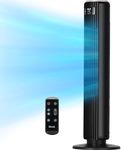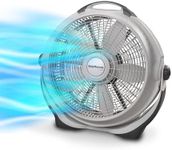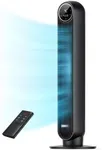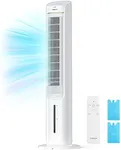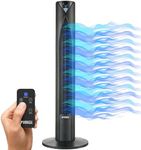Buying Guide for the Best Quiet Floor Fans
Choosing the right quiet floor fan can make a significant difference in your comfort, especially during hot weather. A quiet floor fan not only helps to cool down your space but also ensures that you can enjoy a peaceful environment without the constant hum of a noisy fan. When selecting a quiet floor fan, it's important to consider several key specifications to ensure you get the best fit for your needs. Here are the key specs to look out for and how to navigate them.Noise LevelNoise level is measured in decibels (dB) and indicates how loud the fan will be when in operation. This spec is crucial if you want a fan that won't disturb your sleep, work, or relaxation. Fans with noise levels below 50 dB are considered very quiet, making them ideal for bedrooms and offices. Fans with noise levels between 50-60 dB are moderately quiet and suitable for living rooms. If you need a fan for a noisy environment, a noise level above 60 dB might be acceptable. Consider where you will use the fan and choose a noise level that ensures comfort and minimal disturbance.
AirflowAirflow is measured in cubic feet per minute (CFM) and indicates how much air the fan can move. This spec is important because it determines the fan's cooling efficiency. Fans with a CFM of 1000 or less are suitable for small rooms or personal use. Fans with a CFM between 1000-2000 are good for medium-sized rooms, while fans with a CFM above 2000 are ideal for large spaces or areas that require significant air circulation. Assess the size of the room and the level of cooling you need to choose the right airflow capacity.
Speed SettingsSpeed settings refer to the number of different speeds at which the fan can operate. This spec is important because it allows you to adjust the fan's performance to your comfort level. Fans with 2-3 speed settings offer basic control and are suitable for general use. Fans with 4-5 speed settings provide more flexibility and are ideal for those who want precise control over airflow. If you need maximum customization, look for fans with more than 5 speed settings. Consider how much control you want over the fan's speed and choose accordingly.
OscillationOscillation refers to the fan's ability to rotate from side to side, distributing air more evenly throughout the room. This spec is important if you want to cool a larger area or ensure that air is circulated throughout the room. Fans with oscillation can cover a wider area and are ideal for shared spaces or larger rooms. If you need focused airflow in a specific direction, a non-oscillating fan might be sufficient. Think about the layout of your room and whether you need widespread air circulation to decide if oscillation is necessary.
Size and PortabilityThe size and portability of a fan determine how easy it is to move and place within your space. This spec is important if you need to frequently move the fan between rooms or if you have limited space. Compact and lightweight fans are easy to carry and store, making them ideal for small apartments or for use in multiple rooms. Larger fans may offer more power but can be cumbersome to move. Consider your space constraints and how often you plan to move the fan to choose the right size and portability.
Energy EfficiencyEnergy efficiency indicates how much power the fan consumes relative to its performance. This spec is important if you want to minimize your electricity bills and reduce your environmental impact. Fans with energy-efficient ratings or those labeled as 'Energy Star' certified use less power while providing effective cooling. If you plan to use the fan for extended periods, an energy-efficient model can save you money in the long run. Consider how often you will use the fan and your energy consumption preferences to choose an energy-efficient option.

